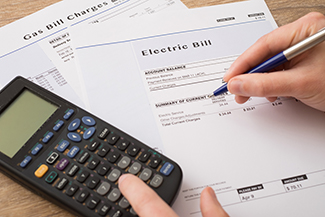Picking Your Power Plan
Picking A Power Plan 101
First, Let's Look at Your Bill
Every utility company charges a service fee to cover operations such as billing and customer service departments and distribution facilities (there may be as many as 14-line items on your bill). There is not much that can be done to impact these numbers.

However, you can make some choices that lead to significant savings. Start by paying attention to how you buy energy. Reading your bill can be challenging if you don't know how. You will find the actual cost of electricity at your home under several line items. Both SRP and APS have separate line items for demand fees and 'on-peak' and 'off-peak' usage. Be sure you can determine the cost of energy within the total bill.
How Energy Is Measured
To begin, it is important to note that energy is measured in kilowatt hours (kWh).
This number is a unit of measure that equals the amount of energy you would use if you kept a 1,000-watt appliance running for an hour. For example, a 100-watt light bulb would take 10 hours to use 1 kWh of energy while a 2,000-watt oven would use 1kWh in a half hour.
The Biggest Thing You Can Do to Impact Your Electric Bill
First, make sure you are on the right plan for your household. Most utility companies now have multiple plans to choose from.
Currently, within one utility company provider in Arizona you can pay from a money saving 3.2kwh up to a wallet crunching 23 kwh! That is an 86% difference for exactly the same product! There is a lot of room for savings if you study the plans.
Choose a plan
Think of the plans as separate rooms for you to buy electricity in.
Room #1 | Standard Rate
This rate is the simplest and easiest to use. This rate is not available to all homes at all utilities. It is a sufficient rate for those who are low energy consumers. Apartments and small homes do well on this rate. There are families who prefer this rate for convenience.
Room #2 | Time of Use Rate
In Time of Use rates you are charged based on when you use your energy. Energy, on this plan, is labeled 'on-peak' and 'off-peak' hours. Shifting energy use to 'off-peak' hours will save money. The more you shift the more you save. It is like buying energy on sale!
Room #3 | Time and Demand Rate

Time and demand rates carry a set demand charge and have the most potential for savings. Rosie says think of it like a cover charge. The fee is the price you pay to use the plan. The lower the kWh on the demand plan you choose, the higher the set demand fee. The set demand rate is multiplied by the highest single hour of usage you incur during 'on- peak- hours each month.
"The demand fee can scare homeowners away" says Rosie Romero, host of the Rosie on the House weekly radio broadcast. But, the price for admission will be worth it if you can adjust your energy consumption to avoid a huge spike during 'on-peak' hours. Romero has encouraged homeowners to try time and demand rates. He says, "We have received many testimonials of people who have saved hundreds of dollars over the course of the summer". Using this rate Romero keeps his home at 70 degrees in the summer and pays 10 cents a kWh. There is definitely a need to manage use on this rate - Rosie calls it Super Cooling! To analyze if the demand/cover price is worth the reduced rate for your household, analyze the living habits in your home- have they changed? Each utility website has a questionnaire to help you choose your plan. After analyzing the choices, make your pick.
Analyze the Data & Do the math!
Once you have 3 months of bills, or using your last 3 months bills, you will be able to analyze your average cost per kWh by following these steps in order:
- Add the total dollar amount from the 3 months.
- Add the total kWh's from the 3 months.
- Divide the dollar amount by the kWh.
What did you come up with? With time and demand rates and flexibility you can get as low as 10 cents a kWh and enjoy real savings! The more you adjust the more you save. Comfort does not have to be an option!
Join every Saturday Morning to find out more!
Home Maintenance Calendar: #UtilityRate
###
Photo Credits: Shutterstock
RELATED CONTENT:
- Blog: Taming Your Electric Bill
- Blog: Six Steps To Big Savings On Your Electric Bill
- Blog: Where Does Arizona Get Its Power?
- Blog: What is a mini-split AC system -- and what are the benefits?
- DIY FAQ: How To Save Money Every Summer By #SuperCooling
- DIY FAQ: Consumer Guide: How to Buy and AC System
- DIY FAQ: Maintaining your Heating and Cooling System
- DIY FAQ: Reading and Understanding Your Utility Bill
- Podcast: 9:00 AM Open Lines! Saving On Your Cooling Bill & Water Treatment
